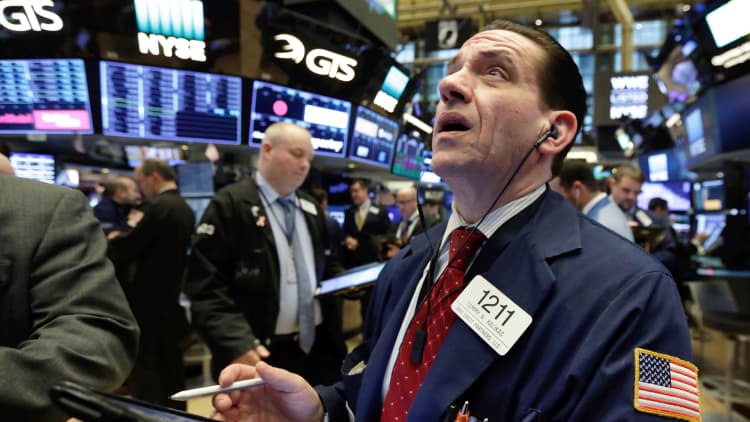
Monday's broad-based sell-off pushed stocks below important technical levels, signaling more pain ahead for the market.
"The story you just can't avoid is the cracking leadership of this market," said James Paulsen, chief investment strategist at Leuthold Group. In afternoon trading, 10 of 11 major S&P sectors were trading at correction levels Monday, 10 percent or more from their highs.
Consumer discretionary and technology shares, former market stars, were the worst hit Monday, with declines of more than 3 percent. The best performer was the defensive utilities sector, down only 1 percent, followed by real estate, off just 1.5 percent.
Some tech names were especially hit. President Donald Trump's criticism of Amazon drove that stock down more than 5 percent, and Intel was off nearly 6 percent on reports Apple would supply its own chips.
"If I look at the global markets, it's really just the U.S. falling apart," said Jeff Kleintop, chief global investment strategist with Charles Schwab. "It feels to me it's a U.S.-concentrated thing, which makes me think it's not as much related to trade as it is to technology and maybe regulatory headaches for some businesses coming out of D.C."
Kleintop said the market has also been dependent on corporate buybacks, and those buyback programs at many companies are expected to be on hold ahead of earnings season, which starts with a slow trickle of reports next week.
"We might feel the impact of no buybacks," he said. "Today is kind of the first day they go away."
Alarm bells went off Monday when the closed below its 200-day moving average for the first time since the British voted to leave the European Union in June 2016. The S&P closed at 2,581, off 2.2 percent.
The 200-day was at 2,589. The widely watched price trend indicator is simply the average of the closing levels of the last 200 sessions.
"We've broken it, and we're sitting below it, which shows real selling, and the longer we stay below, the more probability we at least test the Feb. 9 low at 2,530-ish," said Scott Redler, partner with T3Live.com.
The Dow and Russell 2000 also briefly dipped below their 200-day moving average, but the focus was on the S&P. Both also slid below their February lows, but the Dow, at one point down more than 750 points, recovered from that level.
A variety of factors weighed on stocks, as investors sought safety in bonds. That drove yields lower, with the 10-year at 2.72 percent and the at 2.23 percent. The dollar also fell, and the dollar index was just above the key technical level of 90.
"Volatility is driven by the combination of fears of a trade war and problems with technology and other things, including possible problems with Korea. This is normal. This is the way the market normally behaves. It's not a surprise, but at the end of the day it's got to be earnings that drive the market this year," said Ed Keon, chief investment strategist at QMA. Keon said the Chinese response to U.S. metals tariffs was harsher than expected.
The heightened volatility, after last year's easy march higher for stocks, also sent the VIX up 18 percent Monday to just under 24. It has been as high as 25.72.
Strategists have varying views of how low the market can go before stabilizing and turning higher, but they all see earnings as the next catalyst — and it should be a good one. They also do not believe we are entering a bear market yet.
According to Thomson Reuters, earnings for the S&P 500 are expected to be up about 18.5 percent in the first quarter, after a near 15 percent gain in the fourth quarter.
"I just think the market's had a bit of a run of bad luck and after a long period of very strong returns and very dormant volatility, it seems the first step is to sell these days. It's too bad, because I think underlying this market, the fundamentals remain very strong," said Michael Arone, chief investment strategist at State Street Global Advisors.
"I think what's likely to happen is now we've broken through the 200-day moving average for the S&P, a level it's defended three other times, you could continue to see this volatility persist," Arone said. "My expectation is that when earnings season kicks off in the next several weeks that could provide some support for the market since I expect earnings to be strong."
WATCH: Stocks falter on trade, technicals



